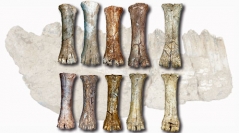

 Geodiversitas
40 (13) - Pages 283-319
Geodiversitas
40 (13) - Pages 283-319The continuous enrichment of the European Pleistocene mammal fossil record leads inevitably to a comprehensive forthcoming review of the biogeographic and evolutionary history of bisons on the continent. New and revised data from the post-Olduvai (<1.8 Ma)-pre-Jaramillo (>1.0 Ma) time span of the Mygdonia basin (N. Greece), exposed here, indicate the presence of a small bison referred to as Bison cf. degiulii (Masini, Palombo & Rozzi, 2013) due to its similarities with the contemporaneous type material from the Italian Peninsula. A series of minor morphometrical changes detected across chronologically successive Mygdonia bison populations is interpreted as local adaptations to harsher environmental conditions. A re-evaluation of several morphological and biometrical features of the European early bison populations in comparison with later and extant taxa leads to the reconfirmation of some characters as taxonomically and phylogenetically important, while questioning others. The results allow recognizing B. degiulii as most likely member of the true bison clade Bison (Bison) Hamilton Smith, 1827 and reconsidering the current B. (Eobison) Flerov, 1972 concept. The data from Mygdonia basin and Northern Greece confirm the short co-occurrence of Bison Hamilton Smith, 1827 and Leptobos Rütimeyer, 1877-1878 in the Balkans and suggest the appearance of at least two bison lineages in Southern Europe between 1.7-1.5 Ma.
Bovini, Bison, Eobison, Early Pleistocene, palaeodemography